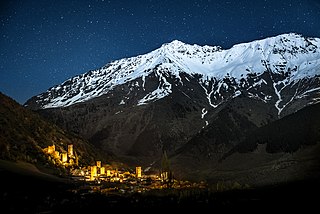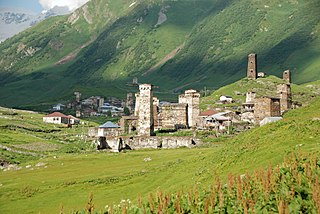
The Khanate of Sibir was a state in western Siberia. It was founded at the end of the 15th century, following the break-up of the Golden Horde. Throughout its history, members of the Shaybanid and Taibugid dynasties often contested the rulership over the Khanate between each other; both of these competing tribes were direct patrilineal descendants of Genghis Khan through his eldest son Jochi and Jochi's fifth son Shayban (Shiban). The area of the Khanate had once formed an integral part of the Mongol Empire, and later came under the control of the White Horde and the Golden Horde of 1242–1502.

The Transcaucasian Socialist Federative Soviet Republic, also known as the Transcaucasian Soviet Federative Socialist Republic, or simply Transcaucasia, was a republic of the Soviet Union that existed from 1922 to 1936.

Nazran is the largest city in Ingushetia, Russia. It served as the republic's capital from 1991 to 2000, until it was replaced by Magas, which was built for this purpose. It is the most populous city in the republic: 122,350 (2021 Census); 93,335 (2010 Census); 125,066 (2002 Census); 18,246 (1989 Soviet census).

Kumyks are a Turkic ethnic group living in Dagestan, Chechnya and North Ossetia. They are the largest Turkic people in the North Caucasus.

Svaneti or Svanetia is a historic province in the northwestern part of Georgia. Running along the Greater Caucasus range, Svaneti is one of the most mountainous regions of Georgia. It is largely inhabited by the Svans, an ethnic subgroup of Georgians.

Mestia is a highland townlet (daba) in northwest Georgia, at an elevation of 1,500 metres in the Caucasus Mountains.

Kumyk is a Turkic language spoken by about 400,000 people, mainly by the Kumyks, in the Dagestan, North Ossetia and Chechen republics of the Russian Federation. Until the 20th century Kumyk was the lingua franca of the Northern Caucasus.

Ushguli is a community of five villages located at the head of the Enguri gorge in Svaneti, Georgia. Compared to somewhat more developed towns like Mestia, Ushguli is not in an accessible location, which has preserved many of the villages' medieval characteristics, including unique defensive tower houses called Svan towers. Because of their preservation and traditional architecture, Ushguli, Mestia, and the surrounding area was recognized as the Upper Svaneti UNESCO World Heritage Site in 1996.

Ambrolauri is a city in Georgia, located in the northwestern part of the country, on both banks of the Rioni river, at an elevation of 550 m above sea level. The city serves as the seat of the Racha-Lechkhumi and Kvemo Svaneti regional administration and of the Ambrolauri Municipality and had a population of 2,015 in 2021. Its area is 2.8 km2. Ambrolauri was first recorded in the 17th century as a place where one of the palaces of the kings of Imereti was located. It acquired the city status in 1966.

Prokofy "Alyosha" Aprasionovich Dzhaparidze or Japaridze,, was a Bolshevik revolutionary of Georgian origin. He was one of the leaders of the Red Army and the Bolshevik Party in Azerbaijan during the Russian Revolution.

Shatili is a historic highland village in Georgia, near the border with Chechnya. It is located on the northern slope of the Greater Caucasus mountains, in the historical Georgian province of Upper Khevsureti, which is now part of the modern-day region (mkhare) of Mtskheta-Mtianeti. As of 2014 census, population of the village was 22.

Bilopillia is a city in Sumy Raion of Sumy Oblast of northeastern Ukraine. It was the administrative center of Bilopillia Raion until it was abolished on 18 July 2020. It is located close to Kursk Oblast of Russia. Population: 15,600. The city's ancient name is Vyr.

Konstantin Nikolaevich Leselidze was a Colonel-General and Hero of the Soviet Union who distinguished himself at the North, Transcaucasus and Ukrainian front during World War II. He was also the elder brother of Viktor Nikolaevich Leselidze

The Principality of Svaneti was a small principality (samtavro) in the Svaneti region of the Greater Caucasus mountains that emerged following the breakup of the Kingdom of Georgia in the late 15th century. It was ruled successively by the houses of Gelovani and Dadeshkeliani, and was annexed to the Russian Empire in 1858.

A vishapakar also known as vishap stones, vishap stelae, "serpent-stones", "dragon stones", are characteristic monoliths found in large numbers in the Armenian Highlands, in natural and artificial ponds, and other sources of water. They are commonly carved from one piece of stone, into cigar-like shapes with fish heads or serpents. Supposedly they are images of vishaps, a water dragon of Armenian folklore. There are about 150 known extant vishap stelae, of which 90 are found in Armenia.

Chazhashi is a village in the Mestia Municipality, Samegrelo-Zemo Svaneti, Georgia. It is located in the southern foothills of the Greater Caucasus mountains, in the upper Enguri River valley, at the elevation of 2,160 m above sea level. The village is part of the historical region of Svaneti and center of the Ushguli community. Its medieval fortified structures are inscribed on the registry of Georgia's Immovable Cultural Monuments of National Significance and listed as a UNESCO World Heritage Site as part of the Upper Svaneti entity.

Svan towers refers to the tower houses built as defensive dwellings in the Georgian historical region of Svaneti. These towers are unique to the region and were primarily built between the 9th and 12th centuries, during the Georgian Golden Age. However, the origins of the tower likely date back to prehistory.

The Colchic Rainforests and Wetlands is a UNESCO World Heritage Site in Georgia, which comprises parts of the Colchis Lowland along some 80 km of western Georgia's Black Sea coastline. It was inscribed by UNESCO on 26 July 2021, becoming the first site in Georgia to be added to the list for its natural attributes. The site contains a wide array of ancient rainforest and wetland ecosystems, harboring many threatened and endangered species.

Armenian-Azerbaijani cultural relations are relations between two ethnic groups in terms of their language and culture.




















